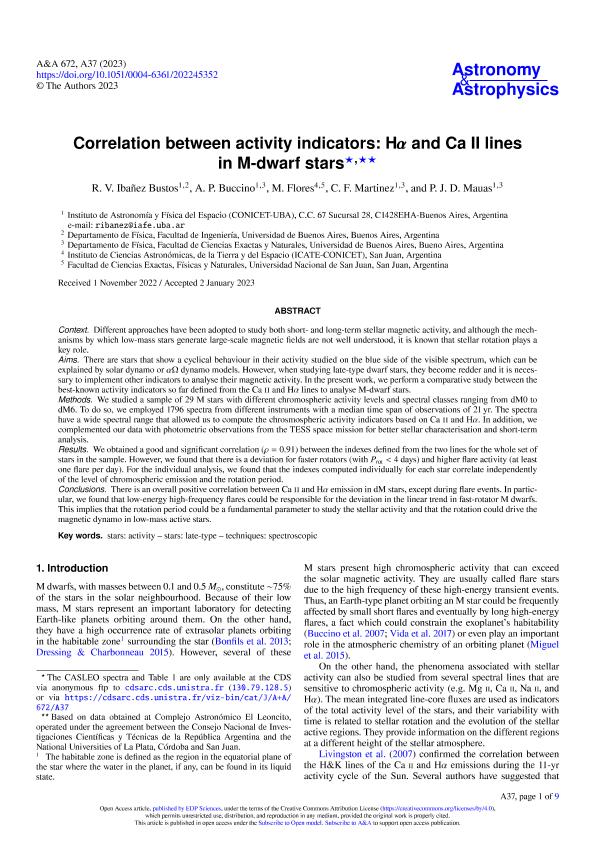Mostrar el registro sencillo del ítem
dc.contributor.author
Ibañez Bustos, Romina Valeria

dc.contributor.author
Buccino, Andrea Paola

dc.contributor.author
Flores, Matías
dc.contributor.author
Martínez, Cintia Fernanda

dc.contributor.author
Mauas, Pablo Jacobo David

dc.date.available
2024-02-21T14:38:54Z
dc.date.issued
2023-01
dc.identifier.citation
Ibañez Bustos, Romina Valeria; Buccino, Andrea Paola; Flores, Matías; Martínez, Cintia Fernanda; Mauas, Pablo Jacobo David; Correlation between activity indicators: Halpha and Ca II lines in M-dwarf stars; EDP Sciences; Astronomy and Astrophysics; 672; 1-2023; 1-9
dc.identifier.issn
0004-6361
dc.identifier.uri
http://hdl.handle.net/11336/227833
dc.description.abstract
Context. Different approaches have been adopted to study both short- and long-term stellar magnetic activity, and although the mechanisms by which low-mass stars generate large-scale magnetic fields are not well understood, it is known that stellar rotation plays a key role. Aims. There are stars that show a cyclical behaviour in their activity studied on the blue side of the visible spectrum, which can be explained by solar dynamo or αΩ dynamo models. However, when studying late-type dwarf stars, they become redder and it is necessary to implement other indicators to analyse their magnetic activity. In the present work, we perform a comparative study between the best-known activity indicators so far defined from the Ca II and Hα lines to analyse M-dwarf stars. Methods. We studied a sample of 29 M stars with different chromospheric activity levels and spectral classes ranging from dM0 to dM6. To do so, we employed 1796 spectra from different instruments with a median time span of observations of 21 yr. The spectra have a wide spectral range that allowed us to compute the chrosmospheric activity indicators based on Ca II and Hα. In addition, we complemented our data with photometric observations from the TESS space mission for better stellar characterisation and short-term analysis. Results. We obtained a good and significant correlation (ρ = 0.91) between the indexes defined from the two lines for the whole set of stars in the sample. However, we found that there is a deviation for faster rotators (with Prot < 4 days) and higher flare activity (at least one flare per day). For the individual analysis, we found that the indexes computed individually for each star correlate independently of the level of chromospheric emission and the rotation period. Conclusions. There is an overall positive correlation between Ca II and Hα emission in dM stars, except during flare events. In particular, we found that low-energy high-frequency flares could be responsible for the deviation in the linear trend in fast-rotator M dwarfs. This implies that the rotation period could be a fundamental parameter to study the stellar activity and that the rotation could drive the magnetic dynamo in low-mass active stars.
dc.format
application/pdf
dc.language.iso
eng
dc.publisher
EDP Sciences

dc.rights
info:eu-repo/semantics/openAccess
dc.rights.uri
https://creativecommons.org/licenses/by-nc-sa/2.5/ar/
dc.subject
STARS: ACTIVITY
dc.subject
STARS: LATE-TYPE
dc.subject
TECHNIQUES: SPECTROSCOPIC
dc.subject.classification
Astronomía

dc.subject.classification
Ciencias Físicas

dc.subject.classification
CIENCIAS NATURALES Y EXACTAS

dc.title
Correlation between activity indicators: Halpha and Ca II lines in M-dwarf stars
dc.type
info:eu-repo/semantics/article
dc.type
info:ar-repo/semantics/artículo
dc.type
info:eu-repo/semantics/publishedVersion
dc.date.updated
2024-02-19T10:38:18Z
dc.journal.volume
672
dc.journal.pagination
1-9
dc.journal.pais
Francia

dc.journal.ciudad
Paris
dc.description.fil
Fil: Ibañez Bustos, Romina Valeria. Consejo Nacional de Investigaciones Científicas y Técnicas. Oficina de Coordinación Administrativa Ciudad Universitaria. Instituto de Astronomía y Física del Espacio. - Universidad de Buenos Aires. Facultad de Ciencias Exactas y Naturales. Instituto de Astronomía y Física del Espacio; Argentina
dc.description.fil
Fil: Buccino, Andrea Paola. Consejo Nacional de Investigaciones Científicas y Técnicas. Oficina de Coordinación Administrativa Ciudad Universitaria. Instituto de Astronomía y Física del Espacio. - Universidad de Buenos Aires. Facultad de Ciencias Exactas y Naturales. Instituto de Astronomía y Física del Espacio; Argentina
dc.description.fil
Fil: Flores, Matías. Consejo Nacional de Investigaciones Científicas y Técnicas. Centro Científico Tecnológico Conicet - San Juan. Instituto de Ciencias Astronómicas, de la Tierra y del Espacio. Universidad Nacional de San Juan. Instituto de Ciencias Astronómicas, de la Tierra y del Espacio; Argentina
dc.description.fil
Fil: Martínez, Cintia Fernanda. Consejo Nacional de Investigaciones Científicas y Técnicas. Oficina de Coordinación Administrativa Ciudad Universitaria. Instituto de Astronomía y Física del Espacio. - Universidad de Buenos Aires. Facultad de Ciencias Exactas y Naturales. Instituto de Astronomía y Física del Espacio; Argentina
dc.description.fil
Fil: Mauas, Pablo Jacobo David. Consejo Nacional de Investigaciones Científicas y Técnicas. Oficina de Coordinación Administrativa Ciudad Universitaria. Instituto de Astronomía y Física del Espacio. - Universidad de Buenos Aires. Facultad de Ciencias Exactas y Naturales. Instituto de Astronomía y Física del Espacio; Argentina
dc.journal.title
Astronomy and Astrophysics

dc.relation.alternativeid
info:eu-repo/semantics/altIdentifier/url/https://www.aanda.org/10.1051/0004-6361/202245352
dc.relation.alternativeid
info:eu-repo/semantics/altIdentifier/doi/http://dx.doi.org/10.1051/0004-6361/202245352
Archivos asociados
